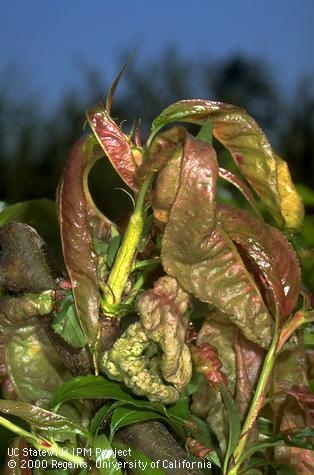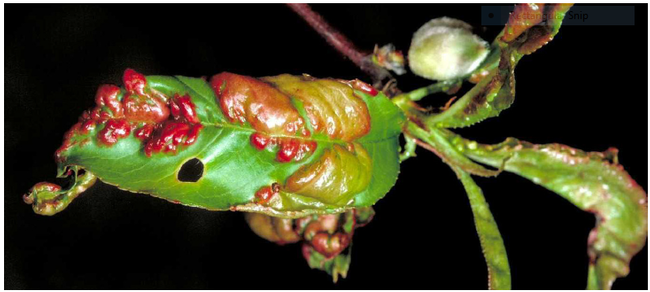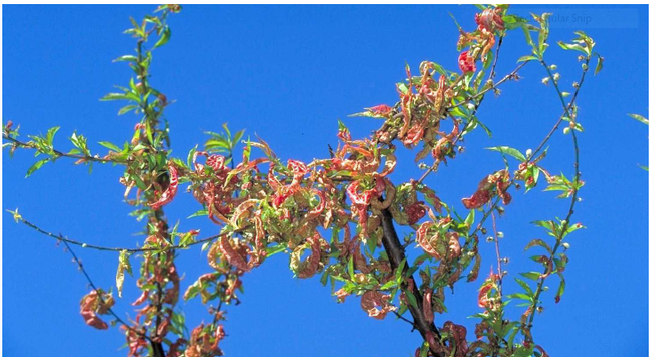Advice for the Home Gardener from the Help Desk of the
UC Master Gardener Program of Contra Costa County
Client's Request: Thank you for calling the UC Master Gardener Program Help Desk this morning with a question about your young peach tree.
You have a young tree, planted bare root into a pot in January 2018, and then transplanted directly into the garden in the late spring / early summer when you were able to do so. You planted several fruit trees at the same time, and all were planted initially into pots and then into the garden, in roughly similar locations, with good drainage in the garden. All of the trees have been similarly irrigated. All of the trees are doing well with the exception of the peach. The peach had curling leaves last year (every single leaf appeared wilted) and you would like to prevent this, this year. You are wondering whether this is “peach leaf curl” or something else, and whether or not to presume it was peach leaf curl and to spray now.

http://ipm.ucanr.edu/PMG/PESTNOTES/pn7426.html
If, after looking at these images, you decide that your leaves looked like this, then I would proceed as recommended in the UC Pest Note linked above.
If you do not think that your leaves looked like this, then we need to consider other possibilities. Wilted leaves can be evidence of a water transport problem in the plant. In this case, something in the vascular system isn't working as it should.
Beginning with the transplant from pot to garden last year, is it possible that the root ball was damaged? Or that there were air pockets in the garden created during transplant, causing some of the roots to dry out? Or that moles, squirrels or other garden visitors have created air pockets near the roots? If you think this is possible then I would dig down and fill those pockets with a wet-soil-sludge mixture to fill them in.
Is it possible that you have overwatered or that the drainage isn't quite as good as you had thought? Good drainage is one of the most important factors in siting fruit trees. Excess water in the root zone will produce a similar-looking result in the plant to a lack of water, since the roots will rot and cannot perform their intended function. In this case be cautious this spring with watering. Once the rains stop and you begin watering again, use a moisture meter or dig down 4 to 6 inches, and learn about your soil. Or perhaps you didn't water enough? Young trees are particularly susceptible to roots drying out. This link discusses irrigation of fruit trees:
http://ipm.ucanr.edu/PMG/GARDEN/FRUIT/CULTURAL/fruitwatering.html
Young trees have undeveloped root systems that are not very extensive. Because of this, your young trees need consistent moisture levels in their root zone in order to thrive. The "goldilocks" amount: not too much, not too little.
Some peaches are susceptible to root-feeding nematodes. Nematodes are tiny, eel-like roundworms. The species that attack plants are usually too small to be seen without a microscope, a soil test will be required. Here is a link to our local ist of soil testing labs for home gardeners. (http://ccmg.ucanr.edu/files/51308.pdf) Different labs perform different tests at different costs. I suggest that you call all or some of the labs to find out if they test for root feeding nematodes, whether or not the tests can provide definitive results, and the costs.
Inadequate nutrition from the soil can also result in discolored and crinkly leaves, look at the pictures at this link:
http://ipm.ucanr.edu/PMG/GARDEN/FRUIT/ENVIRON/nutrientdefic.html
The soil test can also provide information about the nutrition available in your garden soil, if you request this.
You mentioned that you purchased the tree from a local nursery. Although a few local nurseries (usually bigger stand-alone ones) also are a grower for some species, they do not grow their own fruit trees, they rather purchase them (this year, last year, and many years prior) from a grower specializing in fruit trees, often in the Central Valley or lately for citrus in the Monterey Bay area. You might take a look at one of the various grower nursery websites and look up the particular variety of peach that you purchased to find out what you can learn. Most of the nursery grown fruit trees are grafted on root stocks. Some rootstocks are resistant to root-feeding nematodes. It might be helpful to know whether you have a more susceptible tree by identifying the rootstock which can often be found in the grower's catalogue or web site..
Overall, this link will give you valuable information on planting, care, and irrigation of young trees. http://homeorchard.ucdavis.edu/8048.pdf
Good luck with sorting this out and please contact us if we can help further.
Help Desk of the UC Master Gardener Program of Contra Costa County (MCW)
Note: UC Master Gardeners Program of Contra Costa's Help Desk is available almost year-round to answer your gardening questions. Except for a few holidays (e.g., last 2 weeks December), we're open every week, Monday through Thursday for walk-ins from 9:00 am to Noon at 2380 Bisso Lane, Concord, CA 94520. We can also be reached via telephone: (925) 608-6683, email: ccmg@ucanr.edu, or on the web at http://ccmg.ucanr.edu/Ask_Us/. MGCC Blogs can be found at http://ccmg.ignore.edu/HortCoCo/ You can also subscribe to the Blog.
Advice From the Help Desk of the UC Master Gardeners of Contra Costa County
Client's Question: Last spring when my peach tree leafed out the leaves were all funny shaped. Can you tell me what the problem is and how to prevent it from happening again?
Photo: Jack Clark Kelly, UC Statewide IPM Project.
Symptoms Appear in Spring:Peach leaf curl first appears in spring as reddish areas on developing leaves. These areas become thickened and puckered, causing leaves to curl and severely distort. Later, affected leaves turn yellow or brown and can remain on the tree or may fall off. They are usually replaced by a second set of leaves that develop normally unless wet weather continues. The loss of leaves and producing new leaves results in decreased growth and fruit production and may expose branches to sunburn.
Photo: Jack Clark Kelly, UC Statewide IPM Project. ©UC Regents.
Peach Leaf Curl Prevention: Preventing peach leaf curl is relatively easy. You must spray peach and nectarine trees with a fungicide during the dormant season every year after leaves have fallen. A single early treatment when the tree is dormant is generally effective. However, with a particularly wet winter or spring, it may be advisable to apply a second spray late in the dormant season, preferably as flower buds begin to swell, but before green leaf tips are first visible.
Types of Preventives:The most commonly used, safest, and effective fungicides available to home owners are “fixed copper products”, but there are other products available as described in the University of California publication on controlling peach leaf curl. This free publication is available on the web at: http://www.ipm.ucdavis.edu/PMG/PESTNOTES/pn7426.html.
Thorough coverage by the spray is the key. In any case, if leaf curl symptoms occurred on your trees last spring, be sure to treat now to prevent more serious losses the following year.
For More Information:You can find more information on growing peaches on UC's Home Orchard web site at: http://homeorchard.ucanr.edu/Fruits_&_Nuts/Peach/
Editor's Note: This is an updated version of an article originally written by MGCC and published in the Contra Costa Times December 4, 2010.
Help Desk of the UC Master Gardeners of Contra Costa County
Note: The UC Master Gardeners of Contra Costa's Help Desk is available year-round to answer your gardening questions. Except for a few holidays, we're open every week, Monday through Thursday for walk-ins from 9:00 am to Noon at 75 Santa Barbara Road, 2d Floor, Pleasant Hill, CA 94523. We can also be reached via telephone: (925) 646-6586, email: ccmg@ucanr.edu, or on the web at http://ccmg.ucanr.edu/Ask_Us/ MGCC Blogs can be found at http://ccmg.ucanr.edu/HortCoCo/ You can also subscribe to the Blog (http://ucanr.edu/blogs/blogcore/blogroll.cfm).
Help for the Home Gardener from the Contra Costa Master Gardener Help Desk
Client's Problem and Questions:
Photo: Craig Lee/The Chronicle
Until about three years ago, our Gravenstein apple tree located in our garden in Martinez was a healthy 35+ year old tree producing an ample crop of apples. Then it began to decline. First, twigs wilted, then dropped off; then, branches, and last summer complete limbs. A "mystery" apple tree nearby, probably about the same age, has shown no signs of distress.
While this was going on, the tree was still producing apples but could not carry them until they were ripe – they dropped off. In early September, we finally cut down what was left of the tree, one slim branch that had developed atou 4 years ago and was still hanging on with foliage, flowering in spring, but had lost its few apples.
What we found was that the trunk started to hollow out about 3 ft above soil level. When we dug around the bottom to get at the roots we discovered that all the very substantial roots were spongy, slightly damp, and smelled moldy, except for one very small part of one root that must have kept the remaining branch alive.
The bottom of the stump is filled with little rootlets. The big roots were so deteriorated that the stump could be pulled out with little force.
1) What caused the tree to die?
2) Whatever it is, can it affect the trees around it, including another adjacent apple tree?
3) Can another tree be planted in its place? Any kind?
CCMG Help Desk's Response:
I am writing this with what I believe you will find to be relatively good news about your deceased gravenstein apple tree. I did have an opportunity to show the debris samples that you brought into our Help Desk office to a plant pathologist. We looked at the samples and discussed the information that you had provided about the decline of the tree and what you had found while you were removing the tree.
The pathologist found no evidence in the samples you had provided that the tree was killed by a pathogen. She concluded that the apple tree may well have just reached the end of its life expectancy. There were signs of fungal growth in the samples (includingTrametes versicolor, commonly known as turkey tail wood rot), but the pathologist said that they were the kinds of fungi that attack wood that is already dead or badly stressed. The presence of the turkey tail fungus could have been the cause of the white spongy areas you reported that you observed while removing the tree. The types of fungi that were present in the sample you brought in should not be harmful to other healthy trees or other plants in your garden. For more information on such “wood decay” fungi, see http://www.ipm.ucdavis.edu/PMG/PESTNOTES/pn74109.html. You can find a photo and information about turkey tail wood rot near the end of the Pest Note.
The pathologist also found no evidence in the samples that the tree had been killed by a root rot problem such as phythopthera (http://www.ipm.ucdavis.edu/PMG/GARDEN/FRUIT/DISEASE/pchphytoph.html) or armillaria (http://www.ipm.ucdavis.edu/PMG/GARDEN/FRUIT/DISEASE/oakrootfungus.html), both of which, if present, could spread and kill other trees and vegetation.
You indicated that the tree was more than 35 years old. Since I am aware that apple trees can live much longer than that, I did some research to find out what the typical expected life span of an apple tree might be. While I didn't find any information specific to California about life expectancy of apple trees, I did find reputable sources in Arizona and in Virginia that each indicate that the life expectancy of a standard size apple tree is 35 to 45 years (and less for dwarf and semi-dwarf trees): http://ag.arizona.edu/pubs/garden/mg/fruit/intro.html and https://pubs.ext.vt.edu/426/426-841/426-841_pdf.pdf. Given that the life expectancy answer was the same in these two very different climate and growing zones, it seems reasonable to generalize it and apply it more broadly to California trees. Thus, it does seem quite possible that the gravenstein apple simply declined and died at the end of its natural life expectancy.
If the adjacent “mystery” apple that you reported liking so much is the same age as the gravenstein, you might want to try grafting scions from it onto a younger tree next spring. If you need assistance with the grafting, you might contact the California Rare Fruit Growers to see if they can recommend classes or someone who could help you. Here's a link to the website for the CRFG's Golden Gate Chapter: http://crfg.org/chapters/golden_gate/index.htm. The group has monthly meetings that are open to the public. They also hold a scion exchange each year—in 2014 it took place in January in Berkeley. You can find information about the meetings and the scion exchange on the same website.
I hope that the mystery apple continues to thrive—both in its current form and perhaps on a younger reincarnation. Maybe you can also find an equally good variety to replace the Gravenstein.
Contra Costa Master Gardeners Help Desk
Editor's Note: The Contra Costa Master Gardener Help Desk is available year-round to answer your gardening questions. Except for a few holidays, we're open every week, Monday through Thursday from 9:00 am to Noon at 75 Santa Barbara Road, 2d Floor, Pleasant Hill, CA 94523.
We can also be reached via telephone: (925) 646-6586, email: ccmg@ucanr.edu, and we are on the web at http://ccmg.ucanr.edu/

